NEWAYGO COUNTY, Mich. — A possible harmful algae bloom was reported by a resident on a lake in Newaygo County earlier this week.
The algae bloom was reported on Hess Lake and later confirmed by the District Health Department #10 (DHD#10) in cooperation with Michigan Department of Environment Great Lakes and Energy (EGLE).
The DHD#10 collected samples from the algae bloom and submitted them for testing to the Michigan Department of Health and Human Services (MDHHS) this week.
Once the samples are tested, results can be found on the state's interactive map of Michigan Harmful Algal Bloom Reports.
In the meantime, signs will be posted near the boat launch on Hess Lake warning people to avoid contact with the water as a precautionary measure.
“Not all algal blooms have cyanotoxins, so it is difficult to tell if it is harmful by looking at it. Harmful algae blooms can be a variety of colors and look like scum in the water with small flecks, like globs and mats, or like spilled paint with a green sheen on the surface,” said Meghan Stih, Environmental Health Supervisor for DHD#10. “The algal toxins that are released can be harmful to aquatic life, pets, and humans, so it is very important to avoid these areas.”
Authorities at the DHD#10 share some guidance when near waterways:
- Avoid direct contact with waterways that appear to be scummy or have a green shade to them
- Do not drink untreated surface water
- Obey posted signage for public health advisories and/or beach closings
- Limit or avoid eating fish from algal bloom impacted areas
DHD#10 says contact with algae blooms can cause illness in humans but can be fatal for pets or other wildlife. People and pets can experience the following symptoms after exposure to algae blooms:
- Rash, hives, or skin blisters at the contact site
- Runny eyes and/or nose, sore throat, asthma-like symptoms, or allergic reactions
- Diarrhea, vomiting, abdominal pain, weakness, tingly fingers, numbness, dizziness, difficulty breathing, or even death resulting from ingesting contaminated water
If you think that you or your pet have been exposed to algae blooms, take the following precautions:
- Immediately remove yourself and/or your pet from the area
- Take a shower and thoroughly rinse off pets with clean, fresh water if they swam in an area with algae blooms to avoid potential toxic ingestion from licking between paws or affected areas
- Seek medical treatment for yourself and/or veterinary treatment for your pet as soon as possible if you think you or your pet may have been exposed to or ingested algal toxins
You can learn more about algae blooms and their effects here.
►Make it easy to keep up to date with more stories like this. Download the 13 ON YOUR SIDE app now.
Have a news tip? Email news@13onyourside.com, visit our Facebook page or Twitter. Subscribe to our YouTube channel.
Watch 13 ON YOUR SIDE for free on Roku, Amazon Fire TV Stick, Apple TV and on your phone.



